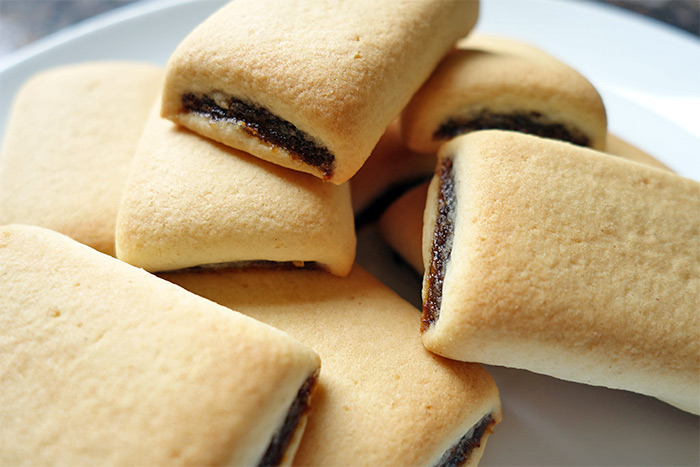
I’ll admit it — I’ve always had a soft spot for fig rolls. They’re sweet, soft, and just a little bit addictive. If they’re in the cupboard, they rarely last more than a day in my house. But here’s the thing: even though they have fig in them, that doesn’t automatically make them a healthy snack.
A lot of people seem unsure about where fig rolls stand. Are they a healthier biscuit because they have fruit in the filling? Or are they simply another sugary treat disguised with a “natural” ingredient? Let’s take a closer look and see what’s really going on inside those chewy, golden biscuits.
Quick Answer: Are Fig Rolls Healthy?
Not really. While fig paste does bring some natural sweetness and a few nutrients, fig rolls are still made with refined flour, added sugar, and fats. They’re low in fibre, high in sugar, and more of an occasional treat than a daily health food.
Think of them the same way you would any other processed biscuit — fine now and then, but not something you should snack on regularly if you’re aiming for a balanced diet.
What’s Inside a Fig Roll?
They might look simple, but fig rolls are more than just figs and flour. Most popular brands, such as McVitie’s, Jacob’s, and Boland’s, follow a similar recipe:
-
Fig paste – makes up roughly 25–30% of the filling.
-
Refined wheat flour – the main base, usually fortified with iron and B vitamins, but still heavily processed.
-
Sugar and glucose syrup – provide sweetness, but also raise the sugar content significantly.
-
Palm oil – helps with the soft texture, but adds saturated fat, which in excess can raise cholesterol levels.
-
Salt – enhances flavour.
-
Sodium bicarbonate – a raising agent to give the dough some lift.
-
Citric acid – adds a slight tang to balance the sweetness.
Even though the ingredient list is relatively short, fig rolls are still a processed snack with refined carbohydrates, added sugars, and fats. And despite the fig filling, the fruit content is too low for them to count as one of your “five a day.”
Nutrition Breakdown
On paper, fig rolls might seem slightly better than some biscuits because they contain fruit. But nutritionally, they’re still closer to a treat than a health food. On average, per 100g they contain:
-
Calories: ~383 kcal (about 65 calories per biscuit)
-
Fat: ~9g (around 4g saturated)
-
Sugar: ~35–37g (about 6g per biscuit)
-
Fibre: ~3–4g total (just 0.7g per biscuit)
-
Salt: ~0.6g
Here’s what that means:
-
Sugar content is high. With around 1.5 teaspoons of sugar per biscuit, just three fig rolls give you close to 19g of sugar. That’s already more than half of the UK’s recommended daily limit of 30g for added sugars.
-
Fibre content is low. You’d have to eat over 7 fig rolls to get 5g of fibre — and the daily target is around 30g. While figs themselves are rich in fibre, there simply isn’t enough in these biscuits to have much effect.

Do They Have Any Benefits?
It’s not all bad news. Fig paste contains minerals like potassium and magnesium, and the fortified flour adds a small amount of iron and B vitamins.
Because they’re high in carbohydrates and sugar, fig rolls can provide a quick energy boost. This makes them a convenient snack for endurance activities like running or cycling, which is why some athletes keep them handy for long training sessions.
However, the positives are small compared to the high sugar and calorie load. They might work well as an occasional sports snack, but they’re not something to rely on for everyday nutrition.
Fig Rolls and Weight Loss
If weight loss is your goal, fig rolls aren’t the best choice. Each biscuit is around 65 calories, but the bigger issue is the sugar. The combination of refined carbs, sugar, and fat means they don’t keep you feeling full for long, which can lead to overeating.
You might get a quick burst of energy after eating them, but it’s usually followed by a crash that leaves you hungry again. Eating them regularly can easily contribute to weight gain. The best approach? Enjoy them occasionally, but don’t make them part of your daily snack routine.
Can They Help with Constipation?
Figs in their natural form are known for helping digestion because they’re high in fibre. Unfortunately, fig rolls don’t offer the same benefit. With less than 1g of fibre per biscuit, you’d have to eat an unrealistic amount to see any real digestive improvement — and by then, the sugar intake would be through the roof.
If you want to improve digestion, stick with whole figs, prunes, oats, lentils, or leafy greens. Fig rolls may taste nice, but they won’t do much for your gut health.
Are They Suitable for Diabetics?
For people with diabetes, fig rolls aren’t the best choice. The high sugar content — most of it added sugar — can cause a sharp spike in blood sugar levels, especially when eaten alone.
They also lack the protein, fibre, or healthy fats that help slow sugar absorption. If you do choose to have them, keep portions small and try pairing them with a protein source, like a handful of nuts, to reduce the blood sugar impact.
Fig Rolls During Pregnancy
If you’re pregnant, fig rolls are generally safe to eat — there’s nothing in them that’s harmful. But they are high in sugar and calories, so moderation is important. Regularly eating large amounts of sugary snacks during pregnancy can lead to excess weight gain, which increases the risk of complications.
If you’re craving something sweet, the occasional fig roll is fine. Just balance it with more nutritious snacks like fruit, yogurt, or wholegrain crackers.
The Bottom Line
Fig rolls might have fruit in the filling, but they’re still a processed, sugary biscuit at heart. They provide a little bit of potassium, magnesium, and fortified nutrients, and they can give you a quick energy boost during exercise. But they’re low in fibre, high in sugar, and not great for managing blood sugar or supporting weight loss.
If you enjoy them, treat them like any other biscuit — something to have occasionally, not daily. They’re best enjoyed with a cup of tea, a bit of nostalgia, and the understanding that they’re a treat, not a health food.
